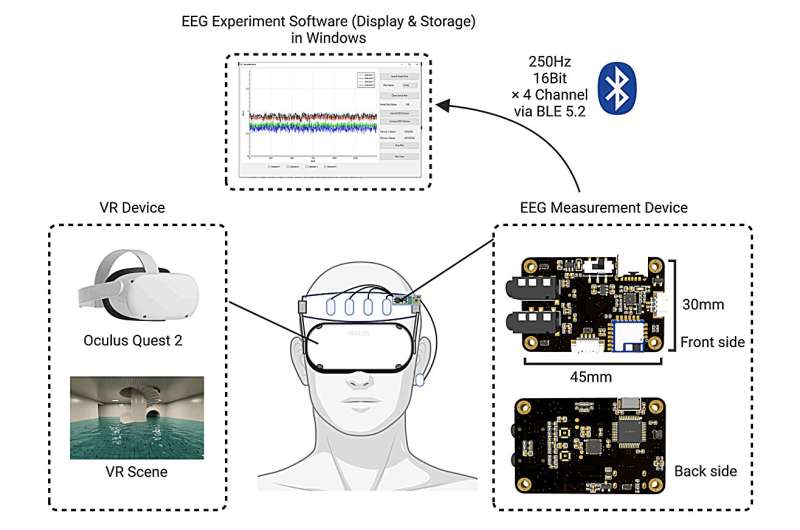February 26, 2024 feature
This article has been reviewed according to Science X's editorial process and policies. Editors have highlighted the following attributes while ensuring the content's credibility:
fact-checked
trusted source
proofread
A low-cost system to collect EEG measurements during VR experiences

Recent technological advances have enabled the development of increasingly advanced systems and devices for measuring brain activity in both research and medical settings. A concept that has been widely explored and yet not effectively realized is that of collecting electroencephalography (EEG) measurements while people are navigating virtual reality (VR) environments.
EEG measurements are recordings of spontaneous electrical activity in the brain, which are typically collected using small electrodes attached to the scalp. These recordings can provide interesting insight about a person's brain activity and can help doctors to detect various conditions, including sleep disorders, epilepsy, brain injuries, and strokes.
Combining these measurements with virtual reality (VR) experiences, neuroscientists can get a better idea of how the brain activity of random individuals or populations with a set of characteristics varies while they are navigating different virtual environments.
While collecting EEG measurements during VR experience could be valuable for psychology and neuroscience research, so far this has proved to be difficult to realize.
The primary reason for this is that most available EEG measurement devices are expensive, uncomfortable for wearers, and bulky. This makes them either inaccessible to research labs or difficult to combine with VR headsets.
Zhiyuan Yu and Shengwen Guo, two researchers at South China University of Technology, recently set out to develop a more affordable EEG measurement system that is also easier to integrate with VR headsets. The system they created, introduced in HardwareX, is low-cost and small, yet it can still measure electrical activity in the brain with high precision.
"This study describes a low-cost (60.07 USD), small-sized, wireless, high-precision, low-power consumption four-channel EEG measurement system (NeuroVista) for frontal area EEG measurements, which can be used with a VR headset, enabling EEG measurements in VR environments," Yu and Guo wrote in their paper.
NeuroVista, the new system proposed by the researchers, utilizes KS1092, a cost-effective biological potential measurement chip. The prototype of the device created by the researchers is comprised of this chip, along with a set of electrodes, and a lithium battery.
Yu and Guo also developed software that translates the signals recorded by the device into digital and storable EEG measurements. To test the effectiveness of their device and software for VR-based experiments, they integrated NeuroVista with an Oculus Quest 2 VR headset, just above the section of the headset that covers a user's eyes.
"The system has an input-referred noise of less than 0.9480 μVrms, a common mode rejection ratio of over 96 dB, a measurement resolution of less than 0.1 μV, a bandwidth of 0.5 ∼ 45 Hz, and works at a sampling rate of 250 Hz," the researchers wrote in their paper.
"It also supports metal dry electrodes and includes a built-in analog bandpass filter, right-leg drive circuit, and built-in digital lowpass filter and notch filter, which can reduce noise during measurement."
The results that NeuroVista attained in initial tests are remarkable, highlighting its potential for conducting psychology and neuroscience experiments that combine precise EEG measurements with VR. As part of further studies, this promising system could also be improved further and adapted for integration with other commercially available VR headsets.
In the future, the new device developed by Yu and Guo could open interesting new avenues for psychology and neuroscience research aimed at observing people's brain activity while navigating specific virtual environments.
Notably, researchers can also easily reconstruct the electrode system to focus on specific brain regions of interest, which further extends its potential applications.
More information: Zhiyuan Yu et al, A low-cost, wireless, 4-channel EEG measurement system used in virtual reality environments, HardwareX (2024). DOI: 10.1016/j.ohx.2024.e00507.
© 2024 Science X Network




















